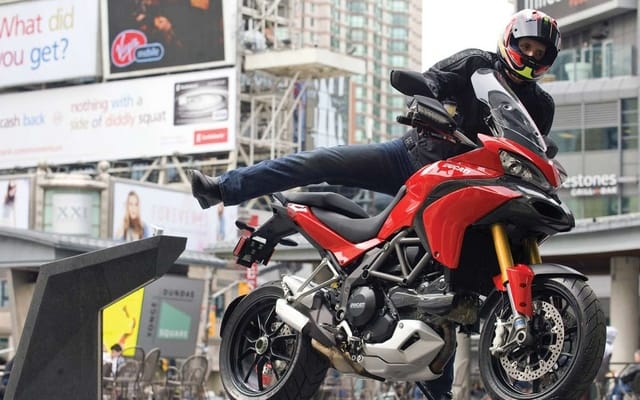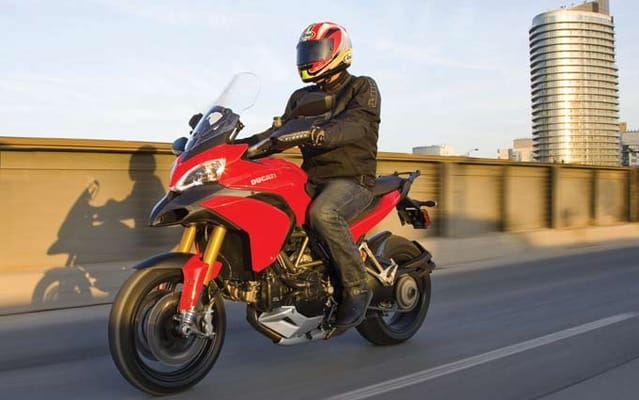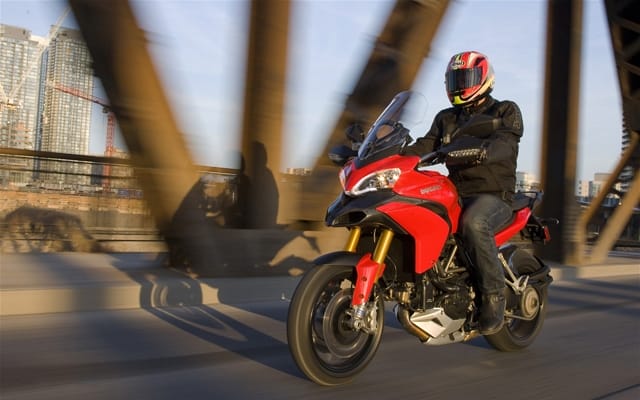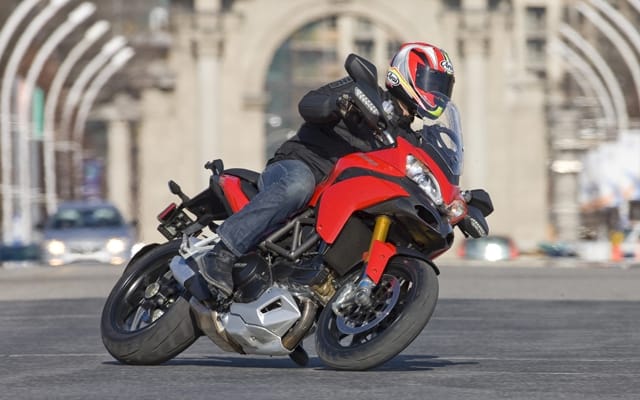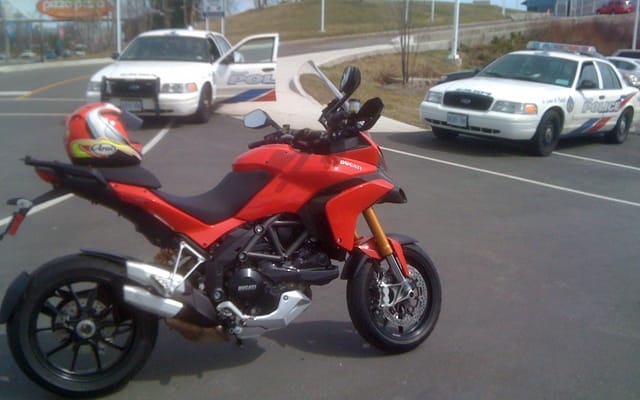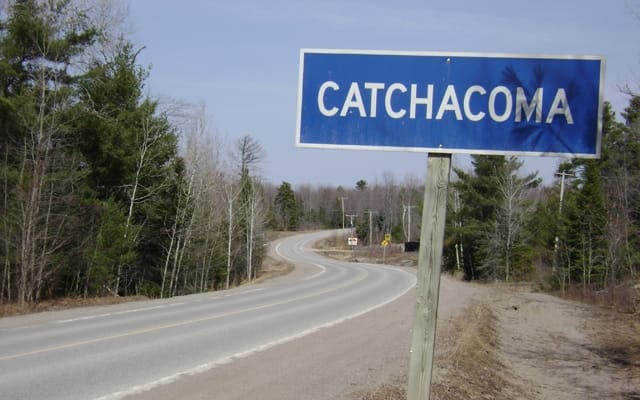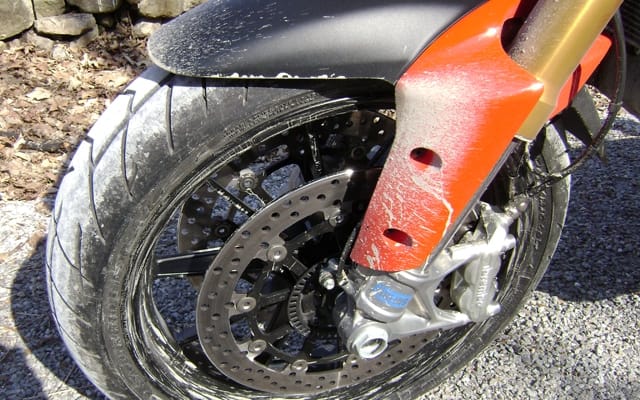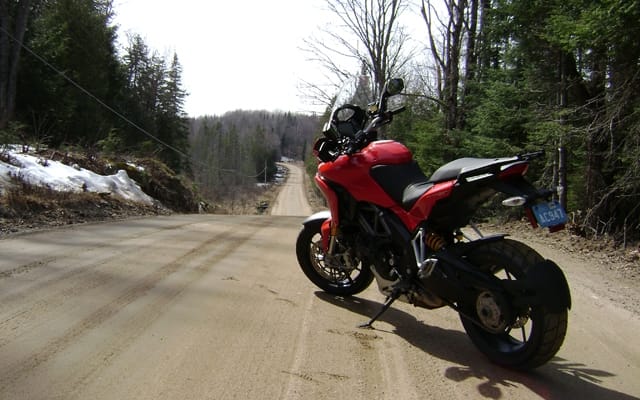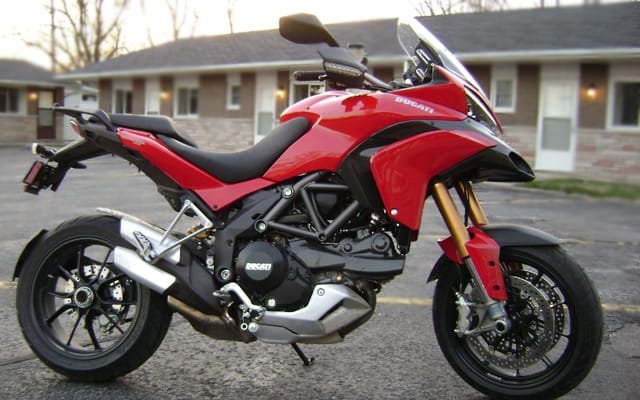When Ducati sticks to what it knows we like the results. And it knows sportbikes and light-footed naked bikes as well as any manufacturer. It’s when they stray that they’ve gotten into trouble in the past—but with the new Multistrada they’re onto something good.
How we love tradition. Our spring test-riding season officially began when web-editor Derreck Roemer (he with the wrist of lead) blew past a cop on the first day of riding our first test bike of the season. “Really?” said Roemer, when told that he was 30 over the limit. “But I was watching my speed.” “I’m sure you were,” said the good-natured cop. “But it’s one thing to watch it and another thing to adhere to the speed limit.” Roemer, knowing that owning up to yet another speeding ticket would be unpopular with the missus, attempted to grovel to freedom by espousing the merits of the most technologically pimped bike we’ve yet ridden. He dutifully droned on to the motorcycle-savvy cop that the Multistrada 1200 S is an 1198 Superbike-powered ABS, DTC, and DES-equipped machine with electronically adjustable power curves, traction control and suspension. In fact, it can do nearly everything—except talk you out of a ticket. Another sad tradition maintained.
Ducati’s belly-flop motorcycles—like the original Multistrada in 2003—are the machines beyond its comfort range. Even the competent—and discontinued—ST series of sport-tourers seemed like diminished Ducatis, the red-blooded vigour of the sportbikes diluted to too thin a viscosity. Perhaps to atone for the original’s failure, Ducati swung for the fences with its new Multistrada.
Every motorcycle, if it is to achieve greatness, must have a great engine. For this, Ducati is luckier than most. Detuned four-cylinder superbike engines never seem to fully accept road-going subservience, but a V-twin—even the monstrously powerful mill from the 1198 Superbike—gains much in the transition down to street level. The reason is that making a twin strong enough to run with Japanese fours requires an engine stretched to snapping. This isn’t necessarily a bad thing—the raw-edged appeal of Ducati superbikes is in part because of this intensity—but the Multistrada shows that something wonderful can happen when engineers take a step back from the quest for all-out power.
Before Ducati diverts the 1198 mill to the Multistrada production line they transform it into the Testastretta 11. The number 11 refers to—wait for it—the engine’s valve overlap expressed in degrees. Valve overlap is the interval of crankshaft rotation (in degrees) where both intake and exhaust valves are open. In the 1198 the valve overlap is 41 degrees. The advantage of large overlap is maximum power; the advantage of less overlap is smoothness and efficiency, as exhaust gases headed down the exhaust pipe don’t compromise the incoming fuel charge. The efficiency gained, according to Ducati, translates into 65 percent lower hydrocarbon emissions and 12 percent better fuel mileage. A side—but significant—benefit is that the improved combustion translates into the doubling of service intervals for the desmodromic valves to 24,000 kilometres. Add a heavy flywheel to mellow it out and it’s the sweetest Ducati engine we’ve yet sampled—and likely stronger at low revs than the Superbike, but what truly sets the Multistrada apart is its suspension.
Ducati’s DES (Ducati Electronic Suspension, developed in conjunction with Ohlins), in cahoots with traction control and ABS, make the Multistrada the most electronically sophisticated motorcycle we’ve ridden. Four user-selectable modes (Sport, Touring, Urban, and Enduro) coordinate engine power levels, suspension settings, and traction control characteristics—all at the touch of a button and while you’re on the fly. (Front and rear compression and rebound damping and rear spring preload are automatically adjusted. Front spring preload must be manually set.) Sport mode, unsurprisingly, is the maximum 140.5 horsepower and 86 lb-ft of torque (as measured on the Pro 6 Cycle dyno) with taut spring preload and firm compression and rebound damping rates. In Sport mode traction control is at level four of eight (number one is least invasive, number eight the most). Touring mode softens the suspension and delivers the same amount of power in a gentler manner, according to Ducati. We couldn’t tell the power difference between Sport and Touring, and the dyno numbers backed it up: Touring mode registered 139 horsepower and 84 lb-ft of torque but we couldn’t see any difference in the power curves between Sport and Touring. The traction control setting in Touring goes to five. Urban mode knocks horsepower to 95, torque to 74 lb-ft, traction control to level six, and further softens suspension settings. Enduro mode retains the Urban power levels but stiffens the suspension and reduces traction control intervention with a setting of two. Oh, we almost forgot, you can also adjust for solo rider, rider with luggage, or rider with passenger and luggage. Got all that?
As complicated as it sounds, in reality it’s easy to use. One push of the turn signal cancellation button activates the dot matrix display on the dash. Then you push it again to toggle through the four modes. Once the mode you want is illuminated, hold the button down and the screen asks that you roll off the throttle to complete the process. Our favourite setting quickly became Touring, as Sport was a little too firm for crumbling Ontario roads. While we liked the Urban setting for the most miserable pavement, we found that “only” 95 horsepower after the full 140 left us wanting. What we wanted was the soft suspension setting of Urban with the power of Sport, a request happily accommodated by the computer. The Multistrada then rode like a mid-’70s Cadillac—perfect for lengthy expanses of expansion crack-scarred highway. (The operator can override all presets, and if you foul it up hopelessly—as we did—pressing default restores the factory settings.)
To test the Enduro mode (and to get the hell out of the office) we took advantage of unseasonably warm spring weather and headed out on a 1,500-kilometre blast into the northland in search of dirt roads. But an hour outside the city and at 130 km/h on the highway we realized that we’d lost the ignition key. We knew this because the words NO KEY were angrily flashing on the dash along with an image of the lost key—just to drive the point home. While the Multistrada indeed has a traditional key, it’s only used to unlock the fuel cap and to access underseat storage, as a chip embedded into the key holder actually “unlocks” the keyless ignition.
Our mistake (we’d like to think that the Multistrada is partially responsible for this) is that the keyless ignition system allowed us to ride off with the key in the lock that releases the seat. The lock, unfortunately, is under the tail section, and we were convinced that the key fob would be lying in a ditch. The bike can be started with a fourdigit pin code that Ducati’s Steve Hicks had shown us, but in our panic the four digits escaped memory. Pulling off the road with the haste of a Formula One pit stop, we wept with joy when we saw the key hanging upside down above the tire. The lesson that we took from this near disaster is that a conventional ignition switch is a very good system for reminding you where your key is—if the bike is running it’s in the ignition. Another glitch is that the fob, which must be within 1.5 metres of the machine (according to Ducati), could be rendered impotent in a jacket pocket by the presence of a cell phone, pocket lint, or a not-so-dense wallet. The easiest solution was to leave the fob in the small storage compartment to the right of the instrument panel. Just don’t forget to take it with you when you walk away.
After lunch in the town of Gooderham, we searched for gravel roads. And did we find one. Had the snaking road been paved it would have been sportbike nirvana, and what we thought would turn out to be a perfunctory spin on the dirt so we could say with confidence that the bike sucks off road, turned into a three-hour thrash. With the traction control automatically set to be less invasive in Enduro mode, we surfed around bends like Jay Springsteen on the Louisville Half Mile. But Springsteen never had (Bosch/ Brembo) ABS. Or a front brake, for that matter. Noticeably pulsing at the lever, the brakes pulled us to safe stops every time. We likely should have fallen off, but we didn’t, and had we not been chased away by a man flailing his arms in a most unbecoming way we might still be there. We have never had the nerve (or, alas, the skill) to ride a road bike of this size with such abandon on dirt, and we were utterly shocked by its capability.
At Four Seasons Parts and Accessories, we asked Lynda Whitefield, who was filling the fuel tank, if she thought we could make it to Perth, via Calabogie, before dusk. (It’s not the dark we’re afraid of, but rather the feeding habits of deer—the editor thwacked one on these very roads a few years ago.) Lynda said that yes, it might be possible. Might. Her skepticism was just the motivation we needed. With our challenge set, our fingers crossed, and the computer in Touring mode, we attacked roads with the desperation of men fleeing fire.
We’ve said it before but it’s worth repeating: the dirt-bike riding position of adventure bikes is the best way to sit on a motorcycle for non-racetrack use. With a broad handlebar, a supportive and comfortable seat (never a given on a motorcycle, much less a Ducati) and low footpegs, it allows the focus to be on the road ahead. Where Ducati has often flubbed its non-sportbikes in the past, the Multistrada gets the details right: generous steering lock makes it nimble on tight roads and in parking lots, the mirrors are nearly vibration-free and offer a view to the rear as good as any that we can recall, and the useful windscreen has 60 millimetres of manual adjustment. (We left it in the highest position, which allowed the eyes to comfortably peer over the top rim.)
We pulled into Calabogie elated and exhausted. We gave the traction control, the ABS, and ourselves a thorough working over. We slammed down mercilessly through the gearbox to be saved by the (wet) slipper clutch and were impressed by the more forgiving feel (vs. the 1198) of the still-ferociously strong brakes. And we remembered where the key was. Life was good until the moment we pulled in front of the burnedout gas station—the only gas station in Calabogie. Continuing south, without fresh fuel, we were tormented by having to keep our speed down to conserve fuel on the sublime road 511. The fuel light had been coming on, depending on how aggressively we rode, between a low of 157 and a high of 190 kilometres. Once, the fuel light came on when we were right in front of a gas station, and the tank accepted 13.7 litres of premium. If the claim of a 20-litre capacity is to be believed, that means an overly conservative reserve capacity of over six litres. Had we discovered the computer toggle button just beneath the turn signal indicator before the very end of the test (which reveals, among other information, the remaining kilometres before the tank runs dry) we could have blitzed the 511 to Perth. Perhaps it was just as well. We’d had a full day.
The Multistrada comes in three variants. For $20,995 you can have your pick of either our tester (the S Sport edition) or the S Touring edition, which substitutes the S Sport’s carbon-fibre cam covers, nose cone, and rear fender hugger with plastic bits but gives you instead hard panniers (57 litres of combined capacity), heated grips, and a centrestand. Both machines share the same electronic suspension components and ABS. A base model, with a manually adjustable Marzocchi fork and Sachs shock, and without electronic suspension or ABS, is $17,495. ABS is a $1,000 option and saddlebags, though no price has been officially announced, are also expected to cost $1,000. But please, don’t buy the base model. Just don’t. You need electronic suspension.
In the past, when we have reviewed BMWs equipped with ESA—its version of electronic suspension—we have received letters from readers questioning its complexity and cost. It is expensive, true, and if problems happen out of warranty it could lead to heartbreak, but it is perhaps the most significant development to happen to motorcycles in the past 10 years. If you were about to head out on a cross-province drive in your car and were told that you’d have to pull off the road and stop to remove tools from a pouch in the trunk to adjust the height of the windows, you’d be rightfully alarmed. Electronic suspension is as useful as roll-down windows in a car—once you try it, it’s hard to live without it.
We’re really at a loss to find much fault with the Multistrada (aside from the irritating, easy-to-lose key). Its non-adjustable 850 mm-high seat might be a problem if your inseam is short, but at least the bike is narrow and light. It is likely the most painstakingly developed machine ever to have come from Bologna, and it’s one of the most capable motorcycles we’ve ever ridden. If you think of Ducati motorcycles as expensive jewelry for posers, we encourage you to look at the Multistrada without this bias—it’s a jewel, yes, but one that can best be appreciated when in motion.
SPECIFICATIONS
MODEL Ducati Multistrada 1200 Sport S
PRICE $20,995
ENGINE Liquid-cooled V-twin with four valves per cylinder
HORSEPOWER 140.5 at 9,250 rpm
TORQUE 85.6 lb-ft at 7,800 rpm
DISPLACEMENT 1198.4 cc
BORE AND STROKE 106 x 67.9 mm
COMPRESSION RATIO 11.5:1
FUEL DELIVERY EFI
TRANSMISSION Six-speed
SUSPENSION Telescopic 48 mm fork adjustable for rebound and compression damping
and spring preload; single shock adjustable for rebound and compression
damping and spring preload
WHEELBASE 1,530 mm (60.2 in.)
RAKE/TRAIL 25 degrees/N.A.
BRAKES Twin 320 mm front discs with four-piston radially mounted calipers;
245 mm rear disc with two-piston caliper. ABS
WHEELS 3.50 x17 front; 6.00 x 17 rear
DRY WEIGHT (CLAIMED) 189 kg (417 lb)
SEAT HEIGHT 850 mm (33.5 in.)
FUEL CAPACITY 20 L
FUEL CONSUMPTION 6.73 L/100 km (42 mpg)
FUEL RANGE 296 km
